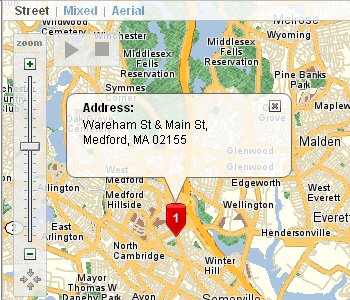 When Ask.com separated itself from
its butler Jeeves,
most of us in the mapping world were only interested in one thing: the updated mapping tools. A quick look by
many geo-geeks was enough to convince them that it didn't compare to
other offerings and, at least now, had no application programming
interface (API). That cursory look failed to put this offering in
context. I spoke with Ryan Massie, senior product manager at Ask.com,
to get at some of that context. During our chat, one word came up time
and again: balance.
When Ask.com separated itself from
its butler Jeeves,
most of us in the mapping world were only interested in one thing: the updated mapping tools. A quick look by
many geo-geeks was enough to convince them that it didn't compare to
other offerings and, at least now, had no application programming
interface (API). That cursory look failed to put this offering in
context. I spoke with Ryan Massie, senior product manager at Ask.com,
to get at some of that context. During our chat, one word came up time
and again: balance.Balance
The team at Ask, he explained, had to balance what it wanted to do in mapping with the rest of the effort to re-brand and re-launch the search engine. It also had to work within a larger framework; that of IAC/InterActiveCorp, its owner. That's important because IAC owns (ready?): The Home Shopping Network, Evite, Citysearch, Ticketmaster and Match.com. So part of the vision was to create a platform that would integrate with these other offerings and update the existing end-user mapping tools. Or, as I put it to Massie, the Ask.com team was "building a platform so it could build its own mashups."
That platform had to be balanced with user needs. Users wanted maps, and still do. Mapping related queries are top 10 searches on Ask.com. While Ask has had a mapping offering since June 2004, this update aimed to improve the experience for the user with draggable maps, multipoint directions, walking directions, and the ability to "right click" to locate a point to become part of a route. And, as Massie is quick to point out, the specific offerings were not a "me too" response to other online mapping offerings, but rather reflected what users wanted.
All the possible additions to the mapping platform also had to be balanced with "getting it done" for the re-launch of Ask.com last month. That meant that some items had to be put on the "waiting list." These included both an API and a method for making the maps available on mobile devices. Massie was not ready to share dates for either at this point.
Differentiating Ask.com
 |
Consider searching for Boston at Google Suggest (beta). You get Google's best guess at what you might be intending to type. The resulting search, a standard Google search, yields at the top a link to map, following by ranked links and to the right, ads.
The same query at Ask.com also yields a link to a map at the top, followed by non-map links, but additionally gives tools to narrow the search to the Boston Massacre, the Tea Party, the band “Boston,” Boston history, etc. Or, you can expand the search to New York or Chicago or Cape Cod or the Freedom Trail. Finally, you might check out some related names, like the Boston Globe or Paul Revere. In a sense, Ask.com has a map of how topics are related that it shares with the searcher for each search.
 |
As Ask.com redefines its brand, it's also doing its part to redefine mapping services. It's staying out of the "me too market" and planning to make its own splash with new functionality for mapping, as well as local search, in the coming months.